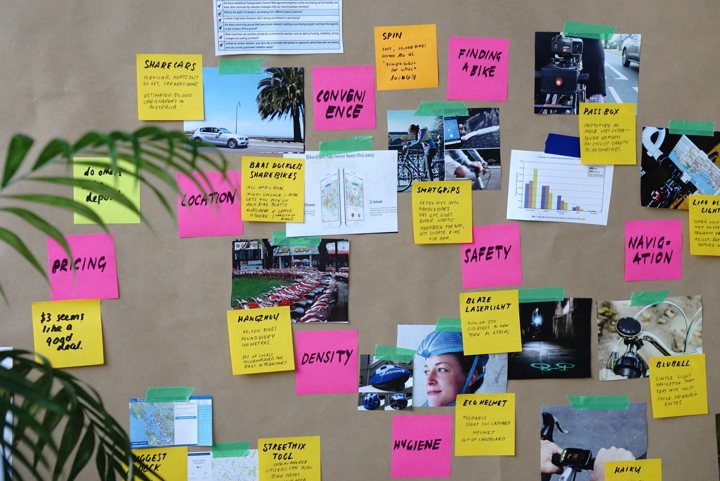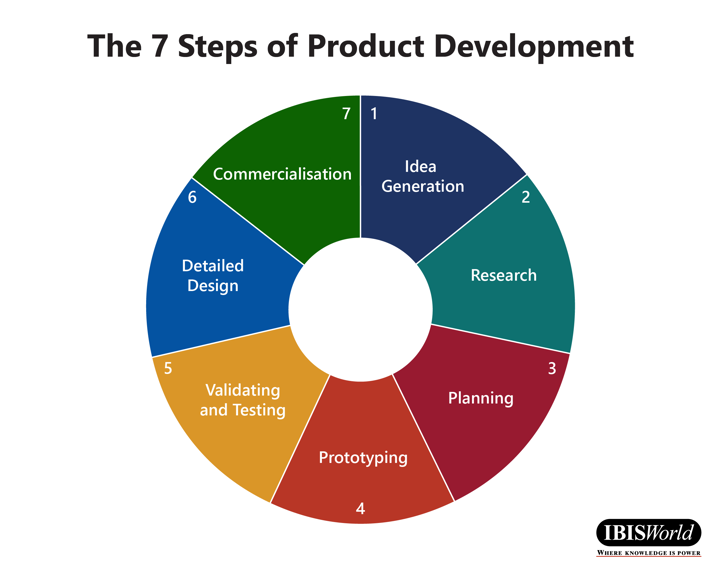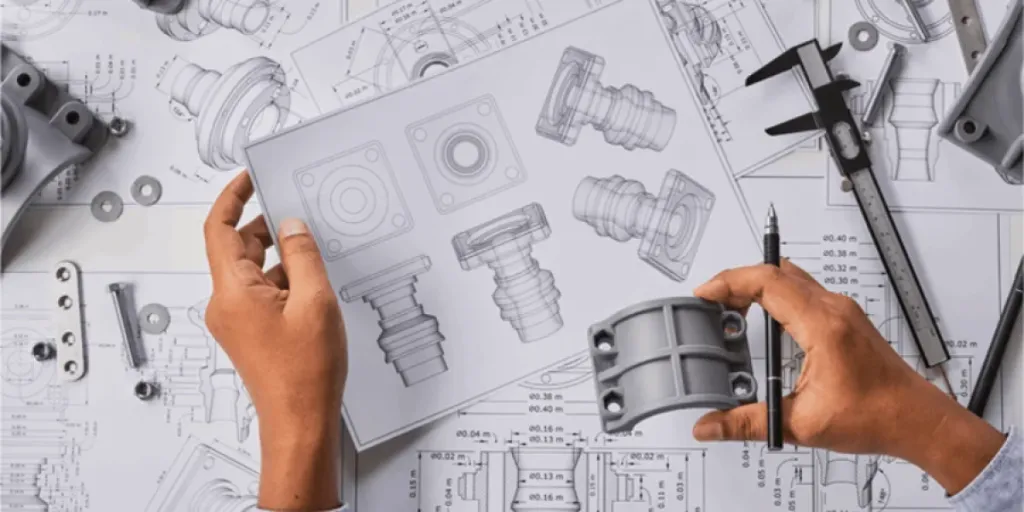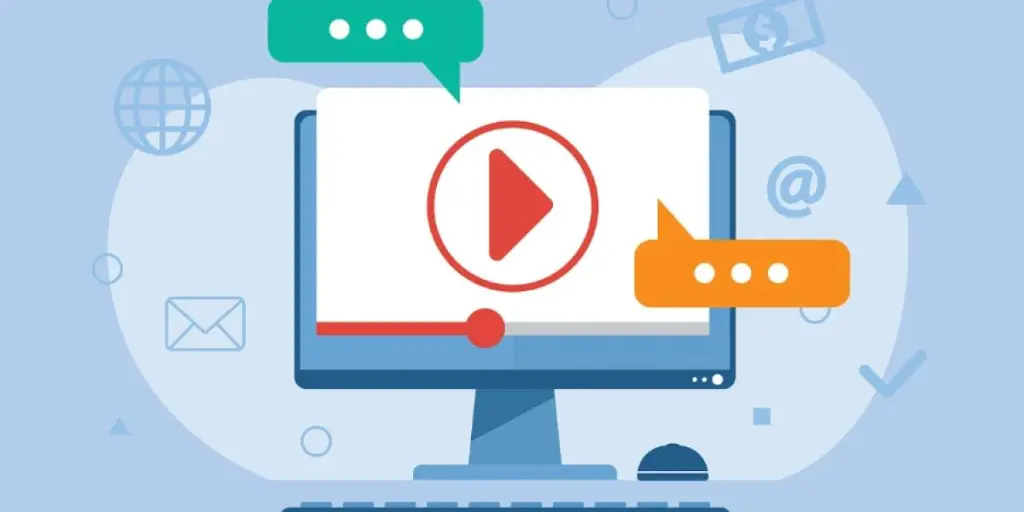Bringing a new product to the marketplace has its challenges, particularly if you have never done it before. Knowing where to start can be puzzling. Thankfully, the product development process will help bring your ideas to life.
From the initial conceptualisation to the final deployment into a market, no two product developments are alike. The once carefully managed stringent waterfall process, where new concept requirements were defined upfront and implemented in distinct phases, has now become a more iterative and agile approach.
Netflix, for example, is courageous in its take on new-product development, keen to evolve and unafraid to dismantle its current strategies. The company bases its product development processes on consumer engagement and retention, with a focus on product testing. Netflix creates and tests rough prototypes following an idea breakthrough, to swiftly validate concepts and leave room for change. This practice has underpinned Netflix’s big-bet decisions, including shifting its DVD mail rental model into a digital streaming model in 2007, which turned the brand into a household name.
On the contrary, e-commerce giant Amazon uses a working backward method: kicking off the development process by imagining a new offering is complete and ready to ship, then planning in reverse. Amazon’s team begins by writing a mock press release that broadcasts the official launch of its new idea. The team will refine the language until a coherent product that delivers new value to customers is actualised. So you see, there is no one-size-fits-all process to developing a new product, but commonalities do exist.
Netflix and Amazon have adopted product development strategies that play to their strengths, allowing them to stay ahead of their competitors and deliver new value to customers. However, echoing the successes of these companies is no easy feat to achieve. Most product launches flop or fall flat of growth expectations. This trend presents a very real risk to young and aspiring entrepreneurs, as introducing products that pull sufficient demand and revenue to sustain operations and withstand competition is an exceedingly difficult challenge.
Let’s dive into the product development process, taking a look at ways to maximise the potential of your product.
What is a product development process?
A New Product Development (NPD) process refers to the steps taken to bring a product to the marketplace. The process begins with brainstorming an idea, followed by researching its potential market, before creating a prototype and then releasing the product to consumers. The process is carried out by new and existing businesses, soles traders and freelancers, and brings together every department of a company, including design, engineering, marketing and manufacturing.
NPD processes do not follow a singular blueprint. Rather, the process is dictated by the complexity of your product or industry. Whether your product is an incremental advancement or a breakthrough invention will change the process you follow.
NPD processes for tech giant Apple are likely to outstrip that of fast-food chain McDonald’s. Apple is notorious for creating innovative, cutting-edge products that are equipped with high-quality hardware and software. Apple’s hardware is carefully designed, produced and assembled using costly materials, resulting in complex, expensive and demanding development lifecycles.
Alternatively, McDonald’s tends to develop temporary products, testing their popularity in the market before making them a permanent menu option. Food and beverage products are also relatively easy and inexpensive to develop, as you may tweak existing recipes or use common ingredients. The processes undertaken by Apple and McDonald’s are therefore very different. Both companies have thrived by understanding their target markets’ wants, cleverly improving products while developing customer-favourite products, with competitors trailing behind.
Companies use product development processes to
- Satisfy a market need or want;
- Compete against other market players with speed or scale;
- Successfully forge a place in the market;
- Achieve long-term growth;
- Test for technical feasibility; and
- Avoid capital deficits.

Despite the excitement that comes with launching a new product, you must not to rush the product development process. Take the process as a marathon, not a sprint, to mitigate the risk of releasing a flawed product.
Apple’s iPhone was a latecomer to the smartphone market, with giants like BlackBerry dominating the market until its release in 2007. At the time, Apple specialised in computers and music, with no name in the smartphone market. However, Apple took its time to develop and test its iPhone, carefully analysing the market and its competitors to understand what was working and what was not. BlackBerry was market complacent and lacked innovation, making it vulnerable to innovative and modern businesses like Apple.
The first iPhone, which featured a touchscreen and App store functions, sparked ground-breaking disruption. Consumers wanted the simplicity and convenience of a virtual keyboard with soft keys, which Apple cleverly engineered. What resembled a pocket-sized tablet ultimately led to the demise of BlackBerry. Timing was the key factor in this changeover – Apple didn’t hurry its iPhone launch, but took the time to perfect a product that outdid its competitors.
When to use product development processes?
Companies engage in product development processes when
- Consumers’ preferences and behaviour change;
- Competition intensifies; or
- A new opportunity to capitalise becomes available.
When a business realise a point to act, they will either
- Develop a brand-new product;
- Improve or upgrade an existing product; or
- Introduce an existing product to a new market.
The product development process lasts a product’s entire life cycle: introduction, growth, maturity and decline. Product introductions don’t stop at the introduction stage. Companies continue to collect and act upon consumer feedback throughout the life cycle, to reintroduce new versions by improving or adding new features.
Coca-Cola, for example, uses AI-powered vending machines to understand consumer behaviour and brand effectiveness. Collected data can underpin new flavour releases. Coca-Cola released Sprite Cherry in 2017 after finding sales were up for both Sprite and Cherry flavoured soft drinks. As your business grows and matures, so will its product lines. To remain current in the market, you must continue to agilely respond to changing consumer needs by introducing new products.
Every product eventually plateaus as consumers shift to alternatives. Some businesses will run a product to the ground, others will redesign it to keep it relevant or in demand. This stage is a great opportunity to introduce new products, kickstarting the product development cycle all over again.
The stages of product development
The NPD process can be summarised into seven steps. From the big and bold tech ideas to the small and safe food ideas, all development projects go through these steps. Although lengthy, and typically iterative, the process is crucial to your product launch’s success.

Step 1: Idea Generation
The product development process starts by generating new products. Budding ideas are discussed in what can be gruelling brainstorming sessions. Discussions are typically centred on the following factors:
a. Target market
Who is the target customer of your product? Create a consumer profile to whom your product will be sold. Your target market is vital to identify from the get-go, as consumers will make or break your new product.
You must also identify the potential success of your target market. Market sizing is a useful tool for estimating the number of potential buyers of your product. It also estimates how much of a market you can win. Market sizing helps validate whether or not your ideas are worth pursuing.
Imagine fishing in the Mediterranean sea, one of the world’s most plentiful fishing spots. Catching fish seems like a breeze. To your dismay, you come away with half-filled buckets, unable to make any substantial profits from their sale. This underwhelming result is due to the coastal regions being overfished by specialised vessels, and your small boat prevented you from fishing further out at sea. This example shows how your product may still fail in a large market (i.e., the Mediterranean sea), if your reach is limited (i.e., the coastal regions) and the market lacks enough customers (i.e., fish) to achieve profitability. You should therefore conduct market sizing to know your realistic market and avoid a disappointing result.
b. Existing products
What specific need(s) will your product satisfy?
Entrepreneurs are often under the misconception that success stems from a swanky new idea. In reality, many of the best ideas are born from iterating an existing product: transforming or adapting it for a new target market or problem. Effectively honing an existing product to satisfy a present or future consumer need screams success.
Apple’s iPhone effectively reinvented the smartphone, debuting a touchscreen. Until 2007, keyboards were all the rage, which made the iPhone all the more daring. But like Apple, consumers quickly agreed that plastic buttons were obsolete, and digital buttons rapidly became a mainstream consumer need.
The SCAMPER brainstorming technique is useful in discovering new product concepts, by asking questions about existing products, and allowing you to refine and modernise old ideas.
c. Value-added
Will your product bring value to the market? You must identify the purpose of your product, and whether or not someone would be interested in purchasing it. The SWOT analysis is an effective way to assess your product’s strengths, weaknesses, opportunities and threats, helping you build a well-functioning and attractive product.
A lot of information can be shared during a brainstorming session. You should therefore consider documenting ideas in the form of a mind map. Easy to create, mind maps ensure your team is equally aware and accepting of ideas and their functions and purpose. Mind maps also help to visualise how different ideas are connected and affect each other.
To further help in creating mind maps, follow one of the links below:
Step 2: Research
Congratulations! You have developed an attractive, value-added idea. Now it’s time to evaluate your market environment. This step allows you to validate whether the market is affluent and fragmented enough to give your product the chance to thrive. Make sure not to rush this step; take your time to investigate the market and analyse potential customers and competitors, as they may be the roadblock to your product’s success.
a. Assess the market
Market research helps you gauge your market’s sentiment. Analysis may relate to how well or poorly consumers are responding to current products, whether gaps exist to exploit, and whether the industry’s life cycle stage (growing, mature, declining) can provide growth opportunities.
The Sleepwear, Underwear and Infant Clothing Manufacturing industry, for example, is in the decline stage of its life cycle. These goods are necessities, meaning upcoming entrepreneurs have a strong potential customer base. Nevertheless, demand for Australian-made sleepwear, underwear and infant clothing is plunging. Instead, consumers are increasingly opting for low-priced items manufactured in China, Bangladesh and Vietnam. The strong competition will likely narrow your chances of making it big with a new product in this industry.
New product launches tend to be most prosperous in the growth stage of an industry’s life cycle. In this stage, early adopters begin to accept a product, with sales starting to grow and profits starting to flow. Market concentration is also low, enabling you to garner a large bulk of the sales and profits. Reaping profit in a mature market is more challenging, and mostly involves incumbent players honing their products to remain competitive.
b. Check your competitors
Industry analysis helps you understand your competitor’s operations, and where you would stand in comparison. Analysis may relate to the number of companies creating similar products, whether or not customers are loyal to existing companies, or if existing products are in dire need of a makeover.
The Fruit Juice Drink Manufacturing industry, for example, is highly concentrated. The four largest players in this industry account for over 70% of total industry revenue. Such a high concentration makes it hard for new players to gain market share and maintain profitability. This factor would be important to consider if your stroke of genius in the ideation stage was to create a new tropical punch fruit juice. Risk analysis is a useful tool to identify potential risks that could dampen your new product’s success in the market, such as strong competition.
Step 3: Planning

You have the idea, and you have a favourable market. Now it’s time to make plans to materialise your idea. In this stage, you will smooth out crinkles in your initial idea, formulating a final product and a comprehensive roadmap to bring your concept to life.
Planning can help you:
- Set deadlines;
- Establish a production budget;
- Identify resources needed to create your product, such as labour, capital, raw materials, and suppliers.
Imagine you want to create a new line of women’s jeans. After thorough market research, you find potential in the niche and sustainable areas of the Women’s and Girls’ Wear Manufacturing industry, leaving you inspired to sketch your final design. To actualise the sketch, you must assemble a network of suppliers, such as cotton, synthetic and natural textile manufacturers. You must also acquire equipment and technology to produce jeans, including sewing machines and material-cutting machinery, which can be a substantial up-front investment. Thinking of all the necessities can be overwhelming, but effective planning will help you coordinate this complicated task.
Australian women’s clothing manufacturer Cue, for example, has been diligently working on a new line of apparel with transparent and traceable production materials and methods. To create this line, Cue is expected to source materials from Good Earth Cotton and FibreTrace. This new collaboration will require Cue to strategically plan ways to streamline supply chains, which will aid the procurement of high margin materials.
Planning involves crafting a marketing strategy that will boost customer interest. While you may revise the initial plan, deciding on which channels (e.g., social media, radio, TV) you want to promote your product early on can streamline the launch process. Planning also involves establishing a pricing model for your product, one that works for both you and consumers.
To further help in creating a product roadmap, follow one of the links below:
Step 4: Prototyping

It’s time for your product concept to come to life. In this stage, you will develop a sample product (a mock-up) of what will eventually launch for consumers. Rarely does the product succeed on the first go. This stage typically involves experimenting with several versions and materials, adjusting or eliminating options along the way.
The prototyping process varies in price and duration, depending on the product’s complexity. For electronics, you may require 3D rendering or designers and engineers that are trained in computer-aided design and drafting software. In this case, entrepreneurs would need to subcontract labour. Immense work and secrecy went into creating the iPhone, with an entirely new hardware system and user interface, which boosted costs for Apple. In comparison, food prototypes are easy and inexpensive to produce, as you can typically make them yourself.
The outcome at this stage is a minimum viable product (MVP). The MVP is a preliminary model of your product with just enough functionality to test it before building the real thing. Doing so helps validate your product concept early in the product development process, while cutting back on initial investment costs. Apple takes a more sophisticated route when building a prototype, investing immense time and effort into maximising the prototype’s functionality. Netflix, on the other hand, opts for a rough prototype with a focus on product testing.
To further help in prototype creation, follow one of the links below:
Step 5: Validating and testing
Time to go live with your product! In this stage, you will validate and test your mock-up and marketing campaign. This stage is critical to identify any risks before you begin mass production. Whether technical glitches need fixing, functions need revising or features need adding, this stage is one of your last chances to make changes. You must continually ask yourself, is the product effectively solving your customers’ needs?
Testing typically includes:
- Alpha Testing (inside the firm) – refers to internal acceptance testing where a company tests a mock-up product in a lab or stage environment.
- Beta testing (outside the firm) – refers to user acceptance testing where a company gives a mock-up product to a group of target users in a real-world environment and asks for feedback. Netflix, for example, uses a beta testing app to roll out updates on a select group of users, before releasing them to all customers. This process ensures the new application is stable and working correctly, leaving room for tweaks.
Step 6: Detailed Design
Almost there! In this stage, you create the final product that will be commercialised. The design should build on your prototype, taking on board the insights gained from testing your MVP. From here, you can begin mass production.
As you will be working with numerous stakeholders and teams during this stage, including product and project management, design, sales and marketing, conducting a stakeholder analysis can be useful. This process determines the relevant parties in your product development design, allowing you to assess and prioritise their demands.
Step 7: Commercialisation

You’ve made it to the final stage! You should now have a profitable and market-ready product. In this stage, you will introduce your product to the marketplace. Your marketing team will take over the project, gearing the product for its launch.
Launch campaigns make your audiences aware of your new product, to help stimulate buzz and prompt people to become customers. Nike’s continued dominance in the sporting apparel market and success in new-product launches can be attributed to its marketing strategy. Nike relies on direct marketing, particularly through social media, with most new products heavily advertised and featuring a high-profile individual. Whether you have a tight or loose marketing budget to work with, there are several marketing tactics available to you, including:
- Television, radio or billboards
- Emails
- Blog posts
- Social Media posts
- Social Media ads
- Search Engine ads
Although this is the final stage, many businesses will continue to improve their products, repeating the cycle. Apple, for example, annually debuts a new iPhone model. Imagine the product development process as a revolving door: your first step marks a shiny new idea, and turns into something market ready as you move through the cycle. Once your product has gone through the process, it will be released out of the door, to then be replaced by a newer idea, or refreshed and rotated back in.
To further help in marketing new products, follow one of the links below:
Key Takeaways:
The product development process is an enriching journey, beginning with budding ideas and moving all the way through to successful products that satisfy customer needs. Finding the right product development process can help streamline future projects and team collaboration, while encouraging innovation. Your customers will remain entertained and satisfied, and you will have found yourself a valuable strategy to repeat.
Source from Ibisworld
Disclaimer: The information set forth above is provided by Ibisworld independently of Alibaba.com. Alibaba.com makes no representation and warranties as to the quality and reliability of the seller and products.




